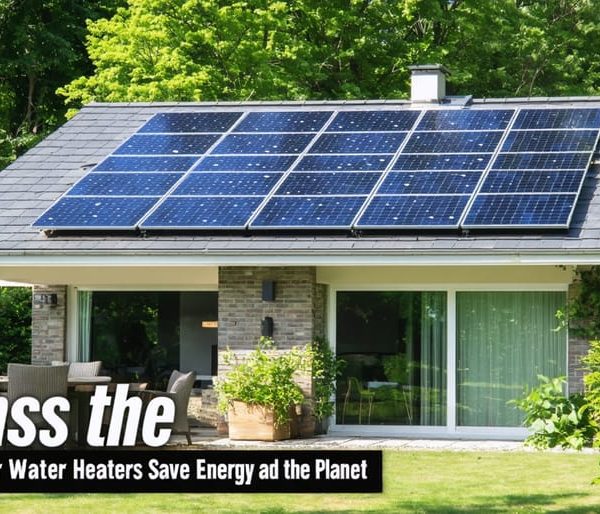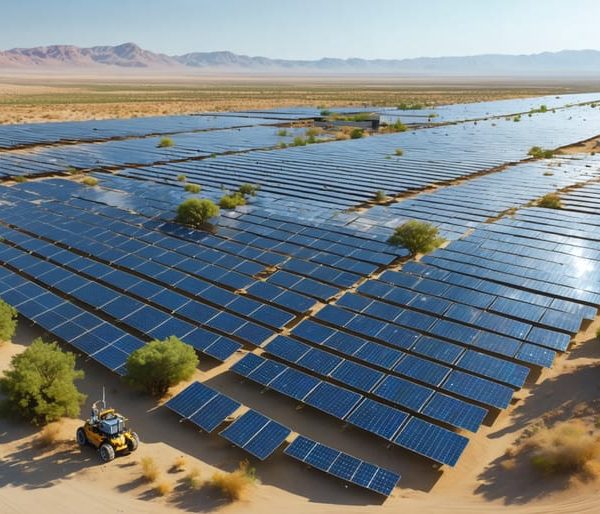Solar Irrigation Pumps: Power Your Garden While Slashing Energy Bills
Transform your garden’s irrigation system into a sustainable powerhouse with solar-powered pumps that harness free energy from the sun. These innovative systems eliminate electricity costs while delivering reliable water flow to keep your landscape thriving year-round. By replacing traditional electric pumps with solar alternatives, homeowners can reduce their carbon footprint while saving up to 70% on water-related energy expenses.
Solar irrigation pumps combine cutting-edge photovoltaic technology with efficient water distribution systems, making them ideal for both small gardens and large agricultural properties. The systems work by converting sunlight into electricity, powering pumps that draw water from wells, ponds, or storage tanks to feed your irrigation network. During peak sunlight hours, these pumps operate at maximum efficiency, perfectly aligned with when your plants need water most.
Gone are the days of complex wiring and high utility bills. Modern solar irrigation pumps offer plug-and-play installation, automated operation, and minimal maintenance requirements. Whether you’re a sustainability-minded homeowner or a tech enthusiast looking to modernize your property, solar irrigation pumps represent the future of smart, eco-friendly gardening solutions.
How Solar Irrigation Pumps Transform Your Garden
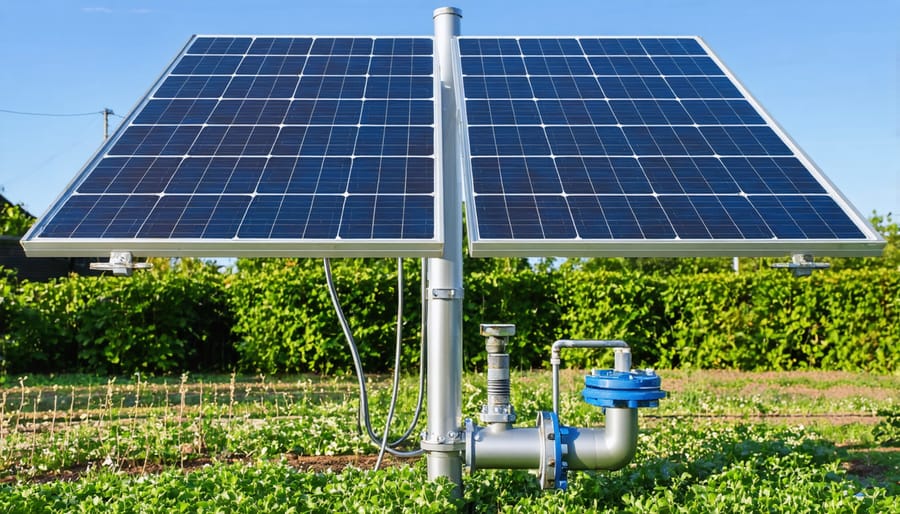
The Smart Garden Revolution
The integration of solar pumps with smart irrigation systems marks a groundbreaking advancement in sustainable gardening. These innovative systems combine solar investment benefits with intelligent water management, creating a self-sustaining ecosystem for your garden. Using smartphone apps and smart controllers, you can monitor soil moisture levels, weather conditions, and water usage in real-time.
Modern solar-powered smart irrigation systems can automatically adjust watering schedules based on weather forecasts, preventing overwatering during rainy periods. Sensors placed throughout your garden communicate with the central controller, ensuring each plant receives precisely the amount of water it needs. This intelligent approach not only conserves water but also promotes healthier plant growth.
The system’s ability to learn from your garden’s specific needs makes it increasingly efficient over time. You can set custom zones for different plant types, adjust flow rates, and even receive alerts when potential issues arise. This revolutionary combination of solar power and smart technology transforms traditional irrigation into a precise, environmentally friendly solution for modern gardening.
Energy Savings You Can Count On
Making the switch to solar-powered irrigation pumps can transform your energy expenses into significant savings. Our analysis of real costs and savings shows that most homeowners recover their initial investment within 3-5 years through reduced electricity bills.
A typical solar irrigation pump can save between 40-60% on energy costs compared to traditional electric pumps. For a medium-sized garden, this translates to approximately $300-500 in annual savings. Commercial property managers often report even higher savings, sometimes exceeding $2,000 per year for larger installations.
Beyond direct energy savings, these systems offer protection against rising utility costs and reduce dependency on the grid. Many users appreciate that their irrigation systems can operate during power outages, ensuring their gardens stay properly watered regardless of external circumstances.
Solar pumps also qualify for various tax incentives and rebates, which can further reduce the initial investment. When combined with smart irrigation controllers, these systems can optimize water usage, leading to additional cost savings while maintaining optimal garden health.
Choosing Your Perfect Solar Pump System
Size and Power Requirements
Calculating your garden’s water requirements is crucial for selecting the right solar pump system. Start by measuring your garden area in square feet and determining the daily water needs of your plants. Most garden plants require about 1 inch of water per week, which translates to roughly 0.62 gallons per square foot.
To calculate your daily pump capacity needs, multiply your garden area by 0.62 and divide by 7 days. For example, a 500-square-foot garden needs approximately 44 gallons of water daily (500 × 0.62 ÷ 7). When harnessing solar power for irrigation, factor in peak sun hours in your location to determine the required pump size.
Choose a pump with a flow rate that can meet your daily water needs within 4-6 hours of sunlight. For our example garden, you’d need a pump that can deliver at least 11 gallons per hour (44 gallons ÷ 4 hours). Add 20% to this calculation as a safety margin for cloudy days and system inefficiencies.
Consider factors like water source depth, elevation differences, and pipe length when selecting pump power. As a rule of thumb, add 1 watt of solar panel capacity for every 10 feet of vertical lift your system requires. Most residential gardens can operate efficiently with 24V systems ranging from 150 to 400 watts.
Essential Components
A solar irrigation pump system consists of several key components working together to create an efficient and sustainable watering solution. The heart of the system is the solar panel array, which converts sunlight into electrical energy. These panels are typically mounted on adjustable frames to maximize sun exposure throughout the day.
The pump itself comes in two main varieties: submersible pumps for wells and surface pumps for above-ground water sources. Both types connect seamlessly with existing water filtration systems for optimal performance.
A charge controller acts as the system’s brain, regulating voltage and protecting the batteries from overcharging. While batteries are optional, they’re recommended for consistent operation during cloudy days or nighttime watering. The system also includes essential wiring, mounting hardware, and piping connections.
Modern systems often feature smart controllers that allow remote monitoring and scheduling through smartphone apps. Optional sensors can measure soil moisture, weather conditions, and water flow rates, enabling automated adjustments for optimal water usage. A backup power inverter can be added to ensure continuous operation during extended periods of low sunlight.
For enhanced efficiency, consider adding a water storage tank and pressure regulators to maintain consistent flow throughout your irrigation zones.
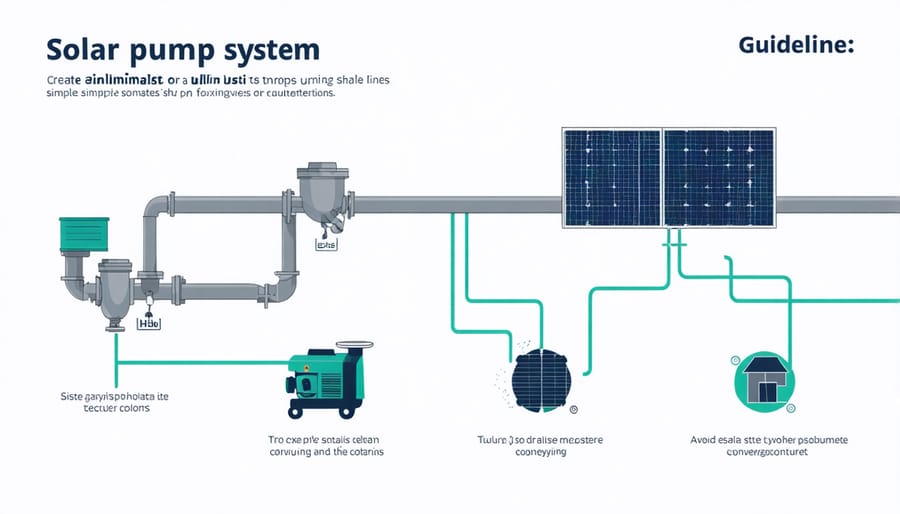
Installation Made Simple
Positioning Your System
Proper positioning of your solar irrigation system is crucial for maximum efficiency and performance. Start by selecting a location for your solar panels that receives unobstructed sunlight for at least 6-8 hours daily. The ideal spot is typically south-facing (in the Northern Hemisphere) with a tilt angle matching your latitude for optimal sun exposure.
Consider seasonal sun patterns and avoid areas where trees, buildings, or other structures might cast shadows during peak sunlight hours. Mount your panels at least 3-4 feet off the ground to prevent dirt splash and allow for easy maintenance. If possible, install them on an adjustable mount so you can optimize the angle based on seasonal changes.
For the pump placement, choose a stable, level surface near your water source. The pump should be as close as possible to both the water source and irrigation area to minimize energy loss through piping. Ensure the pump is protected from direct exposure to weather elements, either through a weatherproof housing or a small shelter.
Keep all electrical connections elevated and protected from water exposure. Install the control box in an easily accessible location, sheltered from rain and direct sunlight. Remember to maintain clear access paths around both the panels and pump for regular maintenance and cleaning.
Don’t forget to consider local building codes and regulations when deciding on your system’s placement. Professional installation might be required for optimal positioning and safety compliance.
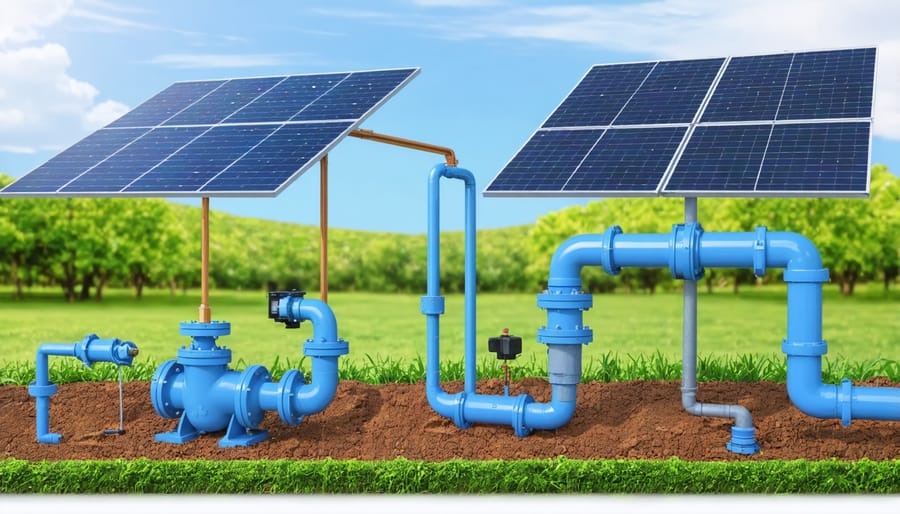
Connection and Setup
Setting up your solar irrigation pump system is straightforward when you follow these steps. Start by identifying an optimal location that receives maximum sunlight throughout the day, typically facing south in the Northern Hemisphere. Ensure the area is free from shade and obstacles.
Begin the installation by mounting your solar panels on a sturdy frame or pole. The panels should be tilted at an angle equal to your latitude for optimal sun exposure. Next, connect the panels to the solar charge controller using appropriate gauge wiring, making sure all connections are weatherproof.
Install the pump controller near your water source, ensuring it’s protected from the elements. Connect the controller to both the charge controller and the submersible pump. If your system includes batteries, place them in a ventilated, weather-protected enclosure and wire them to the charge controller.
For the irrigation components, connect your pump to the main water line using flexible tubing or PVC pipes. Install necessary valves and filters to prevent debris from entering the system. Create a proper drainage system to avoid water pooling around electrical components.
Before first use, prime the pump and check all connections for leaks. Run a test cycle during peak sunlight hours to ensure proper operation. Monitor the system’s performance for the first few days and make any necessary adjustments to optimize water flow and pressure.
Remember to regularly clean the solar panels and check all connections to maintain optimal system performance.
Maintenance Tips for Long-Term Performance
Regular maintenance is key to keeping your solar irrigation pump running efficiently for years to come. Start by cleaning your solar panels monthly using plain water and a soft cloth to remove dust and debris. During dry seasons, you might need to clean them more frequently to maintain optimal power generation.
Check all electrical connections quarterly for signs of corrosion or loose wiring. If you notice any discoloration or damage, contact a qualified technician immediately. The pump itself should be inspected monthly for any unusual noises, vibrations, or changes in performance.
Keep an eye on your system’s filters and clean them every two weeks during peak usage. Clogged filters can reduce pump efficiency and potentially cause damage. When cleaning, gently remove the filter and rinse it with clean water – avoid using harsh chemicals that might damage the components.
Monitor your battery bank’s performance (if your system includes one) by checking fluid levels and terminal connections every three months. Top up battery cells with distilled water when needed, and ensure terminals remain clean and corrosion-free.
During winter months, if your region experiences freezing temperatures, drain the pump and pipes to prevent frost damage. Consider installing freeze protection mechanisms if your system needs to operate year-round.
Create a maintenance log to track cleaning dates, performance changes, and any repairs. This record helps identify patterns and potential issues before they become serious problems. Remember, a well-maintained solar irrigation pump can last 15-20 years, making your investment in sustainable irrigation truly worthwhile.
For optimal performance, schedule a professional inspection annually to catch any issues that might not be visible during routine maintenance.
Solar irrigation pumps represent a smart investment in both our environment and our future. By harnessing the sun’s energy to power our irrigation systems, we can significantly reduce energy costs while contributing to a greener planet. The benefits are clear: lower utility bills, reduced carbon footprint, minimal maintenance requirements, and reliable performance even in remote locations. As water and energy conservation become increasingly crucial, solar irrigation pumps offer a practical solution that aligns with sustainable living practices. Whether you’re a homeowner looking to maintain a garden or a property manager overseeing larger landscapes, making the switch to solar-powered irrigation is a decision that pays dividends both financially and environmentally. Take the first step toward sustainable irrigation today – your garden and the planet will thank you.


